When WordPress breaks, it can be pretty frustrating to try and figure out what’s causing the issue. It’s especially annoying when the problem doesn’t resolve for hours and blocks you from using an important part of your site.
Are you getting a strange error on your Updates page preventing you from upgrading WordPress core or even your theme and plugins? Sometimes this problem will sort itself out, but if you’ve waited a long time and you’re still stuck on this message, it’s not likely to resolve on its own.
Let’s go over why this problem happens and a few suggested ways to get your site working again.
Check Out Our Video Guide to Fixing the “Another Update is Currently in Progress” Error
Causes of the Update in Progress Error
When your site is working as intended, going to the Dashboard > Updates screen will show your current version of WordPress. You can also initiate an update for WordPress core, your theme, or your plugins.
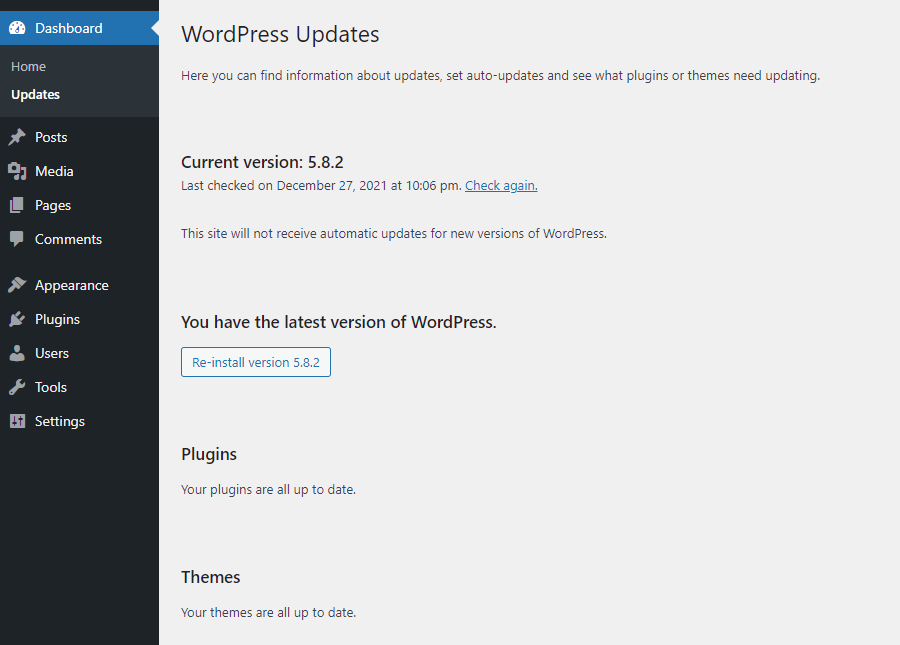
But if your site has updated recently, you may notice a brief message has taken over or appears when you attempt to update or reinstall anything: “Another update is currently in progress.”
This removes all the update buttons and prevents you from doing anything else on the page.
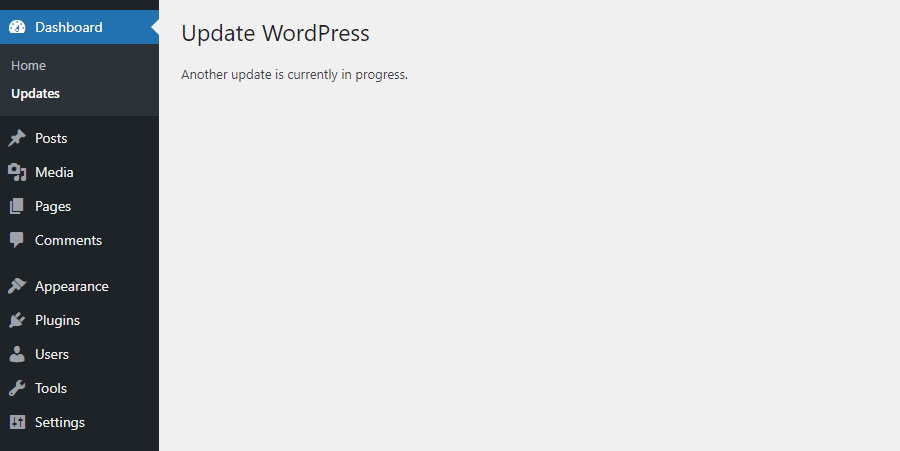
If you know that you just ran an update, this is actually intended functionality to keep you from accidentally breaking your site while an update is downloading.
If you didn’t start the update yourself, it may have been caused by the auto-update function or another user on your site with high-level privileges could have initiated the update process.
But while it’s normal to see this screen while an update is running, it’s not normal for it to stay there for hours on end.
WordPress does intentionally lock your database, but sometimes the lock doesn’t get removed properly. Maybe the update didn’t finish properly due to a server connection blip or something else that went wrong, but you could get stuck on the “Update in progress” screen indefinitely.
Why Core Updates Lock the WordPress Database
So why the strange message? Why would WordPress intentionally block off access to the updates screen like this?
Whenever WordPress runs a core update, it adds a row to the database to prevent any other updates (including plugin and theme updates) from running during the update, sometimes up to 15 minutes after completion. It doesn’t matter if the update takes 5 seconds to install; updates will still be blocked for 15 minutes.
There’s a good reason for this. If a database table is updated simultaneously from two different sources, it could result in database corruption and serious data loss on your site.
For example, if you run a theme and a core update at the same time, there’s a small chance that both operations could end up modifying the same database table and taking your whole site down.
This update lock prevents you or any other auto-update routine from corrupting your site and your important data.
That’s why it’s recommended you wait out the 15 minutes and don’t attempt to manually remove the lock to run a second update, as it could have serious consequences.
But if you’ve been waiting and waiting and your Updates page just isn’t fixing itself, you will need to take manual action. (And when you’re done, you may want to check out our guide to repairing database tables in case the failed update broke anything).
3 Ways To Fix the WordPress Update in Progress Error
It’s normal to see the “update in progress” message for about 15 minutes after an update is initiated, so don’t jump to messing with your database too quickly. But if you’ve waited some time and are still seeing the error, it’s probably time to take further measures into your own hands.
Wait at least an hour since you first noticed the message, then try out one of these steps. Always remember to backup your database and your site as a whole before editing back-end files, especially if you aren’t familiar with the process.
And if none of these steps work or you’re just not comfortable trying to fix it on your own, you can always contact your host and ask for their assistance.
Use a Plugin
Usually fixing this problem requires digging through your database or getting accustomed to advanced developer tools like WP-CLI, but if you don’t want to risk breaking anything, there’s a much simpler option available.
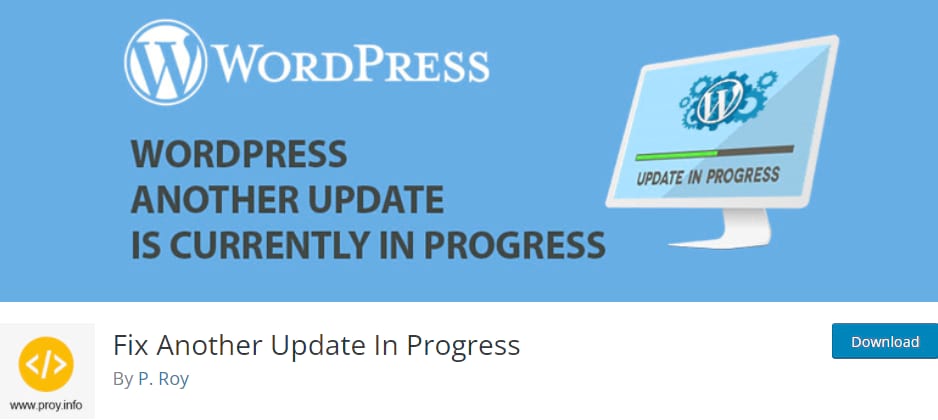
The Fix Another Update In Progress does exactly what it indicates on the tin. While it’s an older plugin that hasn’t been updated in a long time, recent reviews indicate that it still works just fine (and its 10k+ active installations attest to that).
There are also not many other alternatives available, so this is the best option in the WordPress repository. But it doesn’t appear to be supported by the developer anymore, so use it at your own risk.
To install it, log in and go to Plugins > Add New. Search for “fix another update in progress” and click to install the plugin.
You can also download the plugin manually and click Upload Plugin on this page.
Once you activate it, you’ll see a new menu under Settings labeled Fix Another Update In Progress.
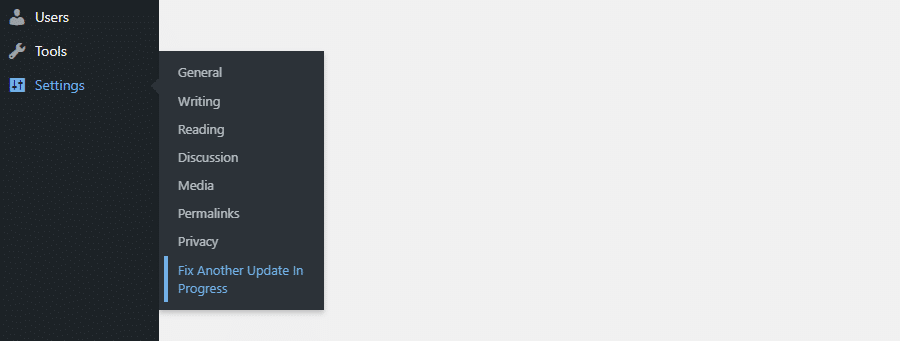
If it detects the lock in your database, it will show this screen. Just click the Fix WordPress Update Lock button and the database entry should be instantly removed.
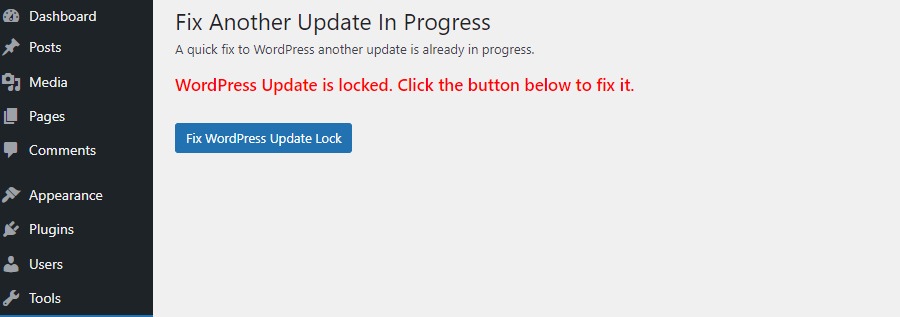
After that, you’re good to go and your “Updates” page should be usable again. It’s not a good idea to leave unused plugins on your site, so you can go ahead and uninstall it if you don’t see this issue cropping up again.
Kinsta customers can use the Kinsta Automatic Updates add-on to easily manage theme and plugin updates based on specific standards you set.
Use PhpMyAdmin
Even if you’ve never delved into your database before, this solution is a fairly easy and safe one as long as you don’t touch any sensitive settings. Just make sure to run a backup before touching anything in your database and only delete the one broken row.
First, you should log into PhpMyAdmin. Kinsta users can open MyKinsta and access PhpMyAdmin through its interface. If you’re using a different host, you can usually access it through cPanel.

On the left menu with several drop-downs, open your site’s database and select wp_options.

Once you click through to wp_options, you should see a table of various database entries. You may see it right in the list, or your table may be far too large. If you can’t find it, use the Filter rows bar above the table and enter “core_updater.lock” to jump right to it.
Now just click Delete on the “core_updater.lock” row.

With that, you’re free to go back to WordPress and update your site again.
Use WP-CLI
If messing with your sensitive database feels a bit too uncomfortable, or all those tables make you feel overwhelmed, there’s a quick and easy solution: WP-CLI.
This is the WordPress command-line interface, a way to interact with your database or other aspects of your site without needing to manually navigate through cPanel and PhpMyAdmin. Enter one line of code and your problem is instantly solved.
Many WordPress hosts these days (including Kinsta) already come with WP-CLI installed, so you don’t need to do any difficult setup.
As with editing your database directly, you should still back up your site before running the command line.
Check out how to connect to SSH for some extra guidance, but here are the basics: Windows users will need to install a program like PuTTY, while Mac and Linux users already have a Terminal built-in.

You’ll also need to get your SSH credentials from your host. You may be able to find this in cPanel under SSH Access, or Kinsta users can find it under the Info tab in MyKinsta.
Windows users should install PuTTY and enter the hostname/IP, port, username, and password provided by your host.
Mac and Linux users can just open the Terminal and enter this command:
ssh username@hostip -p portnumber
Enter your password if prompted.
Now, whether you’re using PuTTY on Windows or the Terminal on Mac or Linux, you should be able to enter commands into your server. Type in the following:
wp option delete core_updater.lock

Getting there is a little difficult, but with that one command, your problems are over.
Summary
The “Another update in progress” error can be very annoying when it does crop up. A small database error can cause a lot of confusion if you end up unable to update your site for days on end.
Luckily, fixing it is a pretty simple task. If you have access to WP-CLI or PhpMyAdmin, you can just delete the lock and your site will go back to normal. If you’re not comfortable doing that, install a plugin that will handle it for you.
And if nothing works, you can always contact your host and ask them to delete the broken database entry themselves.
Just remember to give the message 15 minutes to an hour before going through the trouble of trying to fix this, as it’s possible it will resolve itself before then. That database lock is put there for a reason, and you can corrupt your database if you remove it before you’re supposed to.
WordPress errors are common and it helps to know what to do when they crop up.


